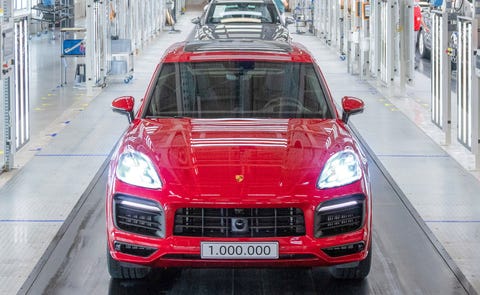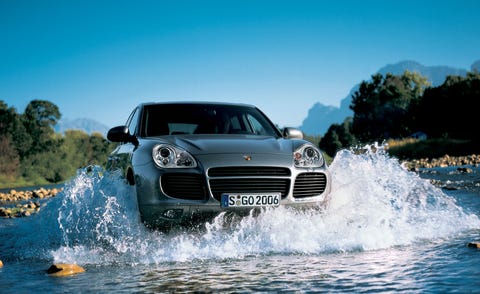- Porsche has just rolled out its millionth Cayenne SUV from its Bratislava, Slovakia, facility, from where it was delivered to a customer in Germany.
- The Cayenne started its life under the code name Project Colorado two decades ago, at a time of massive changes for Porsche's lineup.
- It took Porsche 44 years to sell its millionth 911 but less than half as long a time to get to a million Cayennes.
Back in 2017, the millionth Porsche 911 sold was worth a celebration, 44 years after its launch. We have heard a bit less about another, perhaps even more incredible success story: Just recently, the millionth Porsche Cayenne left the assembly line in Bratislava, Slovakia. The bright red GTS, pictured below, went to a customer in Germany. It needed less than half the time of the 911 to reach this production number, despite a similarly ambitious price.
Conceived about two decades ago, the Cayenne—or the "Colorado" project, as it was internally called—was not exactly uncontroversial. A brainchild of then CEO Wendelin Wiedeking, it came after the company had gone through a whirlwind of changes. They included killing off the V-8–powered 989 four-door sedan, switching the 911 to a water-cooled architecture, and launching the Boxster, which shared a large number of components with the new 911.
An SUV, critics argued, would take Porsche far away from its core: building lightweight sports cars. And it would expose Porsche's distribution network to a different set of buyers, much closer to the mainstream. On the other hand, the Cayenne would still be a lifestyle product, stylish and with driving pleasure as its main purpose.
Ferdinand Piëch saw another upside of the project. Ever the strategist, he immediately saw the potential for further derivatives to be developed for the growing stable of brands in his empire. Colorado, a joint project of Porsche and Volkswagen, took shape in the form of the Cayenne and the VW Touareg. But a few years later, another derivative was launched: the Audi Q7. Wiedeking was not too happy, while Piëch smiled.
The Cayenne and the Q7 became rather different vehicles, with distinctly different design and powertrain options. Inside, the Touareg offered lavish appointments that evoked the style of the Phaeton, while the Cayenne remained closer to the styling language of the 911.
In typical Piëch-era fashion, the Colorado project was characterized by technological overkill, and one reason was that the companies were hoping to sell the SUVs to military customers. These plans did not materialize, but the ruggedness and extreme off-road capabilities remained with the production car.
The First Generation
Launched in fall 2002 at the Paris auto show, the first-generation Cayenne was offered with three engines: an entry-level 3.2-liter VR6 made by VW, plus two versions of a 4.5-liter V-8, one naturally aspirated and the other turbocharged. Immediately, the Cayenne redefined the segment with its awesome power and lofty top speed of a ungoverned 165 mph, later increased with factory power kits. While the Cayenne Turbo was incredibly fast, its distant sister model, the Touareg V10 TDI, became the king of torque. And Piëch, ever ready to point out the issues where it hurts, reportedly drove a Cayenne but had it fitted with the Touareg interior.
The Cayenne almost instantly became Porsche's top-selling model, and with its success it managed to silence many critics. Ultrafast, with stunning handling heretofore unknown to SUVs, it was fun to drive and offered prestige. The profits raked in by the Cayenne allowed Porsche to keep refining the 911, many critics grudgingly admitted.
However, it attracted another set of critics: environmentalists. Driven to the max, the Cayenne exhibited shocking drinking habits. And things weren't helped by the facelift launched in the 2007 calendar year, which added power. The VR6 grew to 3.6 liters and the V-8 to 4.8 liters, with increasing power levels. A GTS model, which had a naturally aspirated V-8 with more than 400 horsepower, was added. And you could still get the Cayenne with a manual transmission, with the exception of the Turbo.
But in 2009, Porsche addressed the fuel consumption issue once and for all with the launch of the Cayenne Diesel, powered by an Audi-sourced 3.0-liter V-6 TDI that turned the portly SUV into a perfect long-distance autobahn cruiser. It was a smashing success.
The Cayenne's off-road capabilties were highlighted by a special edition, the Transsyberia, built in just 26 units and now a sought-after collectible. It was inspired by the 2007 victory of a private Cayenne in the iconic Transsyberia Rallye.
The Second Generation
The 2010 Geneva auto show saw the launch of the second-generation Cayenne, with an entirely new body attached to an evolution of the predecessor's platform. It became lighter thanks to the revised doors and electric system—and the deletion of the low-range transfer case. The manual transmission was gone, too, with the exception of early VR6 models. And the interior improved vastly with a far more contemporary style, reminiscent of the Panamera, and better materials.
The powertrain portfolio was the widest ever in the second generation, ranging from the VW-made 3.6-liter VR6 to a naturally aspirated 4.8-liter V-8 that was replaced by a Porsche-bred V-6 turbo in late 2014 and the turbo 4.8-liter with a maximum of 570 horsepower. There was, for the first time, a hybrid, based on a supercharged Audi 3.0-liter V-6, and the 3.0 V-6 TDI was complemented by an incredibly smooth and torquey 4.2-liter V-8 TDI. The 2015 model year saw a midterm facelift.
Current-Gen Cayenne
Good things came to an end in late 2017, for something even better: the current, third-generation Cayenne. While the new model's looks remained surprisingly similar to the predecessor, the Cayenne was now based on the Audi-engineered MLB platform shared with a large number of Volkswagen Group cars and SUVs, including the Bentley Bentayga and the Lamborghini Urus.
And this allowed for many improvements, including cutting-edge telematics and infotainment systems. The engine portfolio was thoroughly upgraded as well, the base model now fitted with an Audi-made 3.0-liter V-6 turbo, the midrange models with a 2.9-liter V-6 turbo, and the range-topping GTS and turbo models with a turbocharged 4.0-liter V-8. Porsche launched two hybrids as well, based on the 2.9 V-6 and the 4.0 V-8. Meanwhile, two production-ready diesel models were killed at the last minute before launch in the wake of the Volkswagen diesel scandal.
Early 2019 provided a convincing answer to those who wondered why the third-gen Cayenne had remained so conservative: Porsche launched a new variant, the Cayenne coupe. Its distinct style and aggressive roofline carried the Cayenne theme forward in a convincing manner, while keeping rear-seat space and luggage room almost identical. Porsche's answer to the BMW X6 was late but great. On to the next million! This time around, no one will question the concept.
This content is created and maintained by a third party, and imported onto this page to help users provide their email addresses. You may be able to find more information about this and similar content at piano.io
"sold" - Google News
December 12, 2020 at 12:01AM
https://ift.tt/3m7NCvN
Porsche Cayenne Reaches Milestone: 1 Million Sold - Car and Driver
"sold" - Google News
https://ift.tt/3d9iyrC
https://ift.tt/3b37xGF
Bagikan Berita Ini


















0 Response to "Porsche Cayenne Reaches Milestone: 1 Million Sold - Car and Driver"
Post a Comment